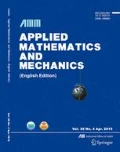Abstract
The instability of the Mack mode is destabilized by wall-cooling in a high speed boundary layer. The aim of this paper is to study the mechanism of the wall-cooling effect on the Mack mode instability by numerical methods. It is shown that the wall-cooling can destabilize the Mack mode instability, similar to the previous conclusions with the exception that the Mack mode instability can be stabilized by wall-cooling if the wall temperature is extremely low. The reversed wall temperature is related to a freestream condition. If the Mach number increases to a large enough value, e.g., about 7, the reversed wall temperature will tend to be zero. It seems that the Mack mode instability is determined by the region between the boundary layer edge and the critical layer. When the wall temperature decreases, this region becomes wider, and the boundary layer becomes more unstable. Additionally, a relative supersonic unstable mode can be observed when the velocity of the critical layer is less than 1 − 1/Ma or is cancelled by the wall-cooling effect. These results provide a deeper understanding on the wall-cooling effect in high speed boundary layers.
Similar content being viewed by others
References
Mack, L. M. The inviscid stability of the compressible laminar boundary layer. Space Programs Summary, 37, 297–312 (1963)
Mack, L. M. The inviscid stability of the compressible laminar boundary layer: part II. Space Programs Summary, IV, 165 (1964)
Kimmel, R. and Poggie, J. Effect of total temperature on boundary-layer stability at Mach 6. AIAA Journal, 38, 1754–1755 (2000)
Kimmel, R. The effect of pressure gradients on transition zone length in hypersonic boundary layers. Journal of Fluids Engineering, 119, 36–41 (1997)
Seddougui, S. O., Bowles, R. I., and Smith, F. T. Surface-cooling effects on compressible boundary-layer instability and on upstream influence. European Journal of Mechanics, Series B, Fluids, 10, 117–145 (1991)
Lysenko, V. I. and Maslov, A. A. The effect of cooling on supersonic boundary-layer stability. Journal of Fluid Mechanics, 147, 39–52 (1984)
Stetson, K., Thomopson, E., Donaldson, J., and Siler, L. Laminar boundary layer stability experiments on a cone at Mach 8 V: tests with a cooled model. 20th Fluid Dynamics, Plasma Dynamics and Lasers Conference, AIAA, Buffalo, New York (1989)
Stetson, K. and Kimmel, R. On hypersonic boundary-layer stability. 30th Aerospace Sciences Meeting and Exhibit, AIAA, Reno, New York (1992)
Mack, L. M. Linear stability theory and the problem of supersonic boundary-layer transition. AIAA Journal, 13, 278–289 (1975)
Mack, L. M. Boundary layer linear stability theory. Special Course on Stability and Transition of Laminar Flow, AGARD-R-709 (1984)
Malik, M. R. Prediction and control of transition in supersonic and hypersonic boundary layers. AIAA Journal, 27, 1487–1493 (1989)
Masad, J. A., Nayfeh, A. H., and Al-Maaitah, A. A. Effect of heat transfer on the stability of compressible boundary layers. Computers and Fluids, 21, 43–61 (1992)
Kara, K., Balakumar, P., and Kandil, O. Effects of wall cooling on hypersonic boundary layer receptivity over a cone. 38th Fluid Dynamics Conference and Exhibit, Fluid Dynamics and Colocated Conferences, AIAA, Seattle (2008)
Liang, X., Li, X., Fu, D., and Ma, Y. Effects of wall temperature on boundary layer stability over a blunt cone at Mach 7.99. Computers and Fluids, 39, 359–371 (2010)
Mack, L. M. Review of linear compressible stability theory. Stability of Time Dependent and Spatially Varying Flows, Springer, New York, 164–187 (1987)
Malik, M. R. Numerical methods for hypersonic boundary layer stability. Journal of Computational Physics, 86, 376–413 (1990)
Muller, D. E. A method for solving algebraic equations using an automatic computer. Mathematical Tables and Other Aids to Computation, 10, 208–215 (1956)
Liu, J. X. and Luo, J. S. Effect of disturbances at inlet on hypersonic boundary layer transition on a blunt cone at small angle of attack. Applied Mathematics and Mechanics (English Edition) 31(5), 535–544 (2010) DOI 10.1007/s10483-010-0501-z
Gao, J. The Method of the Stability Analysis and Receptivity to Acoustics in Supersonic Boundary Layers (in Chinese), Ph.D. dissertation, Tianjin University, Tianjin (2014)
Lees, L. and Lin, C. C. Investigation of the Stability of the Laminar Boundary Layer in a Compressible Fluid, Technical Report, National Advisory Committee for Aeronautics (1946)
Lees, L. The Stability of the Laminar Boundary Layer in a Compressible Fluid, Technical Report, National Advisory Committee for Aeronautics (1947)
Schmid, P. J. and Henningson, D. S. Stability and Transition in Shear Flows, Springer Science and Business Media, New York, 249 (2001)
Fedorov, A. Transition and stability of high-speed boundary layers. Annual Review of Fluid Mechanics, 43, 79–95 (2011)
Author information
Authors and Affiliations
Corresponding author
Additional information
Project supported by the State Key Program of National Natural Science Foundation of China (No. 11332007) and the Young Scientists Fund of the National Natural Science Foundation of China (No. 11402167)
Rights and permissions
About this article
Cite this article
Zhang, S., Liu, J. & Luo, J. Effect of wall-cooling on Mack-mode instability in high speed flat-plate boundary layers. Appl. Math. Mech.-Engl. Ed. 37, 1219–1230 (2016). https://doi.org/10.1007/s10483-016-2125-6
Received:
Revised:
Published:
Issue Date:
DOI: https://doi.org/10.1007/s10483-016-2125-6




